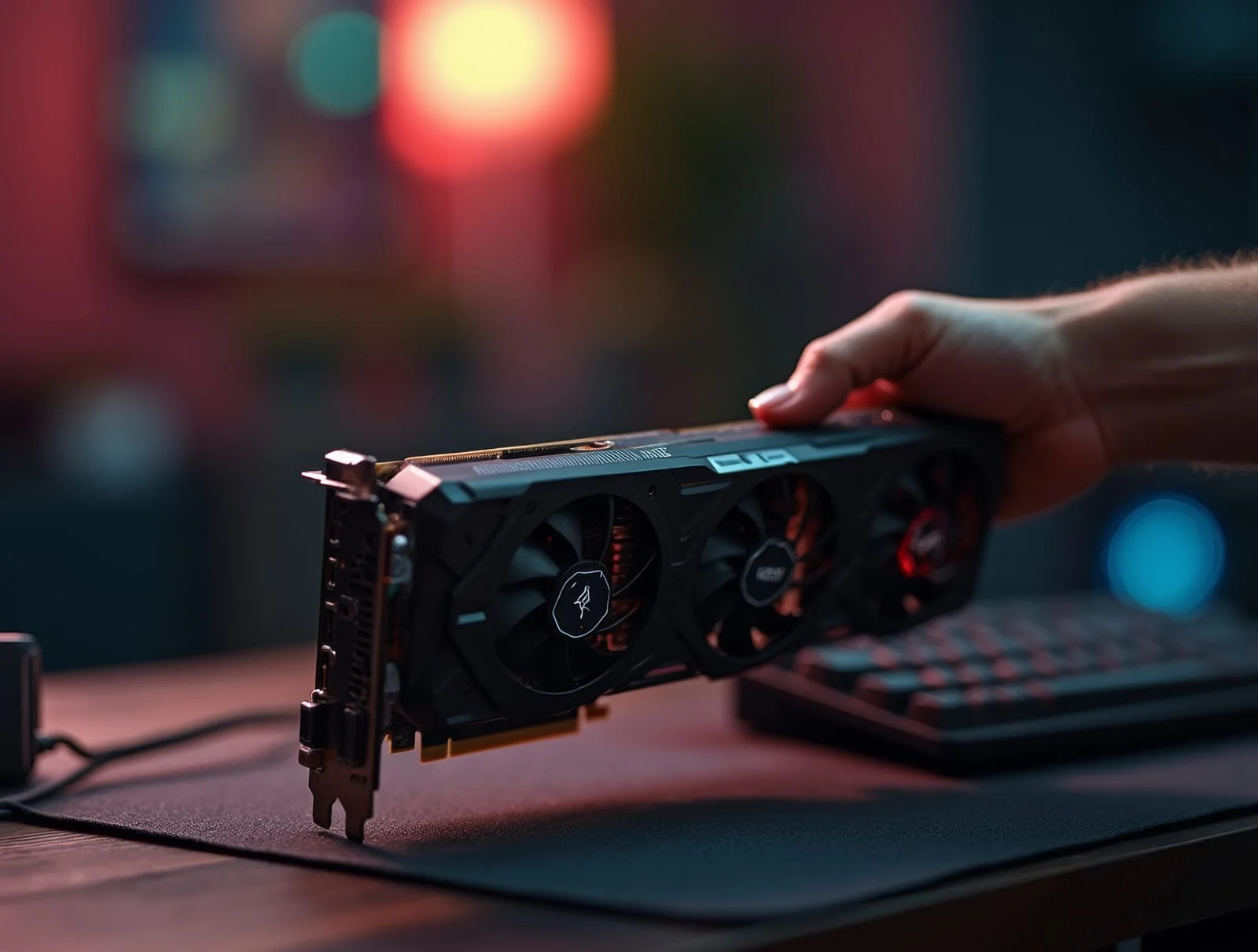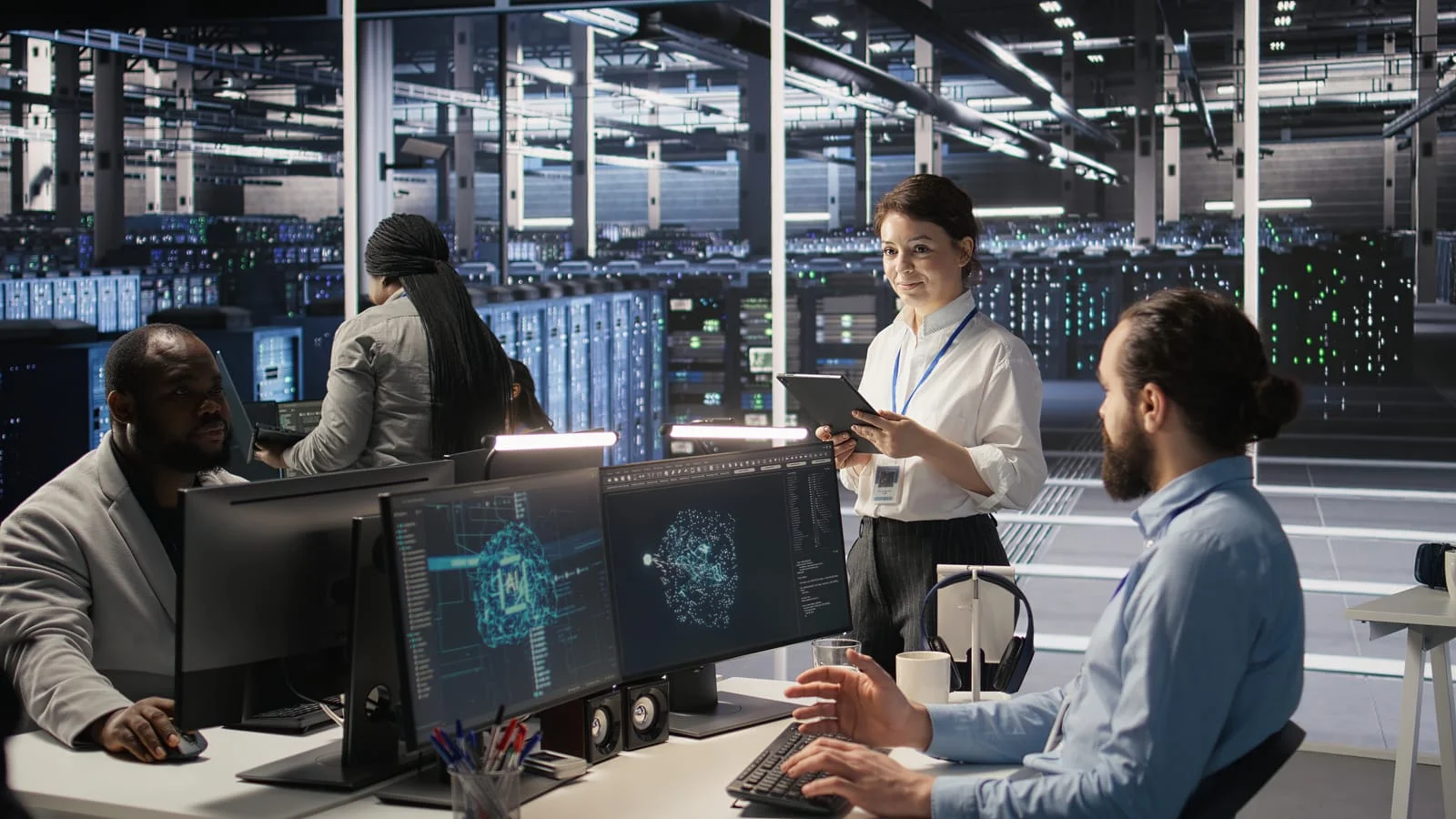A training run crashes at 90% completion. Inference latency suddenly triples. Memory errors corrupt model checkpoints. According to Meta's research on training Llama 3 405B across 16,384 NVIDIA H100 GPUs, during a 54-day period, 30.1% of disruptions stemmed from GPU failures while 17.2% came from memory failures.
For development teams, researchers, and startups depending on GPU infrastructure for AI workloads, recognizing the signs of GPU failure before catastrophic breakdowns prevents data loss, protects research investments, and maintains operational continuity.
GPU failure manifests through patterns that range from subtle performance degradation to complete system crashes. Understanding these symptoms enables proactive intervention—catching failures during maintainable windows rather than during critical production deployments or irreplaceable training runs.
Visual Anomalies: The Most Obvious Indicators
Graphics corruption represents one of the most immediately noticeable GPU failure symptoms, though its relevance varies for computational workloads versus display-focused applications.
Artifacts and Screen Corruption
Visual artifacts appear as unexpected pixels, geometric distortions, or color aberrations during rendering operations. For teams developing computer vision models or working with image generation, these artifacts corrupt training data or inference outputs. The symptoms manifest as random colored pixels scattered across rendered frames, geometric shapes appearing distorted or fragmented, or textures flickering or displaying incorrectly.
While headless computational workloads may not display traditional visual artifacts, the underlying GPU errors that cause them still corrupt numerical computations. Memory errors producing visual corruption also corrupt tensor operations, gradient calculations, and model parameters.
Display Output Problems
Complete loss of display output, system freezing during GPU-intensive operations, or displays showing incorrect resolutions indicate advancing hardware degradation. These symptoms often precede total GPU failure, providing warning windows for backup and migration planning.
Performance Degradation: Silent Failure Progression
Performance drops often precede obvious failure symptoms, making monitoring computational benchmarks critical for early detection.
Unexplained Slowdowns
Training runs taking significantly longer than baseline measurements, inference latency increasing without workload changes, or batch processing throughput declining progressively all indicate potential GPU degradation. Performance degradation may result from thermal throttling due to failing cooling systems, memory bandwidth reduction from developing errors, or compute unit failures, reducing parallel processing capacity.
Establishing performance baselines for standard workloads enables detecting degradation before it impacts critical operations. A model that typically trains in eight hours suddenly requiring twelve suggests investigating GPU health rather than assuming workload complexity alone explains the difference.
Inconsistent Processing Times
Variability in execution time for identical operations signals instability. Neural network inference producing highly variable latency despite consistent input sizes, training epochs showing erratic completion times, or identical computational kernels executing at dramatically different speeds all suggest developing hardware issues.
This inconsistency often indicates intermittent failures—components operating normally most of the time but occasionally encountering errors that force retries or reduced clock speeds. These intermittent issues frequently worsen over time.

Memory Errors: Critical Failure Indicators
GPU memory failures corrupt data silently, making them particularly dangerous for machine learning workloads where incorrect computations may not produce obvious errors until models perform poorly in production.
Types of Memory Errors
Error Type | Description | Impact on ML Workloads | Detection Method |
Single-bit errors (SBE) | Single-bit flip, correctable by ECC | Minimal if ECC enabled | System logs, monitoring tools |
Double-bit errors (DBE) | Multiple-bit corruption, uncorrectable | Data corruption, checkpoint damage | Crashes, incorrect outputs |
Row failures | Entire memory rows inaccessible | Reduced effective memory capacity | Out-of-memory errors, crashes |
Bandwidth degradation | Memory throughput declining | Progressive performance loss | Benchmark comparisons |
ECC (Error-Correcting Code) memory detects and corrects single-bit errors automatically, but cannot fix double-bit corruption. Modern data center GPUs include ECC protection, but consumer-grade GPUs typically lack this safeguard. Teams using consumer GPUs for development work face a higher corruption risk from undetected memory errors.
Recognizing Memory-Related Failures
Symptoms of GPU failure related to memory manifest through training runs producing NaN (not a number) values unexpectedly, saved model checkpoints loading with corrupted weights, or inference returning dramatically incorrect results despite a correct model architecture. Memory errors also trigger out-of-memory failures despite workload fitting within VRAM capacity, crashes during memory-intensive operations like gradient computation, or system logs showing ECC error counts increasing over time.
Monitoring tools like NVIDIA's nvidia-smi or vendor-specific utilities expose memory error counters. Increasing error counts—particularly uncorrectable errors—demand immediate attention before catastrophic failure.
Thermal Issues: Environment-Driven Failures
Temperature stress accelerates GPU degradation and triggers throttling that mimics other failure modes.
Overheating Symptoms
Modern GPUs implement thermal protection through automatic throttling when temperatures exceed safe thresholds. This throttling reduces clock speeds to lower heat generation, manifesting as performance degradation that seems like hardware failure but actually represents protective measures.
Key thermal warning signs include:
GPU temperatures consistently exceeding 80-85°C during normal workloads
Fan speeds ramping to maximum during operations that previously ran quietly
Thermal throttling events appearing in monitoring logs
Training performance declining in hot ambient conditions
Sudden crashes after extended high-load periods
Data center environments running H100 or H200 GPUs dissipating 700W require sophisticated cooling infrastructure. Cooling system failures—blocked airflow, failed fans, degraded thermal paste, or insufficient air conditioning—quickly push GPUs into thermal throttling or protective shutdown.
Cooling System Degradation
Failing cooling systems produce GPU failure signs before the GPU itself degrades. Fan bearing wear creates increasing noise levels and reduced airflow. Dust accumulation in heatsinks progressively reduces thermal transfer efficiency. Dried thermal interface material between the GPU die and the heatsink creates thermal barriers.
Regular maintenance, including airflow verification, dust removal, and thermal paste replacement, extends GPU lifespan significantly. Data center operators implementing preventive maintenance schedules experience substantially lower failure rates than reactive-only maintenance approaches.
System Stability Problems
GPU failures often manifest through broader system instability rather than isolated GPU-specific symptoms.
Crash Patterns
Specific crash patterns indicate GPU-related causes:
Systems crashing during GPU initialization at boot, preventing proper hardware detection
Processes terminating unexpectedly when launching GPU-intensive operations
Blue screens or kernel panics occurring specifically during computational workloads
Random system freezes requiring hard resets during training or inference runs
Driver crashes that leave the system unresponsive or requiring an immediate reboot
Driver crashes deserve particular attention. While occasional driver issues occur in stable systems, frequent driver resets, inability to recover from driver crashes, or systems requiring reboots after GPU hangs indicate progressing hardware failure rather than software bugs.
Application-Level Failures
Machine learning frameworks crashing during training runs, CUDA or ROCm runtime errors terminating processes, or computational kernels failing with hardware errors all indicate developing GPU problems. Modern ML frameworks include error handling, but persistent failures despite correct code suggest investigating hardware health.
Systematic Diagnostic Approaches
Identifying GPU failure symptoms requires methodical investigation rather than assumption-based troubleshooting.
Monitoring and Logging
Implement comprehensive GPU monitoring covering:
Temperature readings captured every few seconds to track thermal patterns
Memory error counters checked regularly for both correctable and uncorrectable errors
Clock speeds and throttling events logged to detect performance limitations
Power consumption patterns tracked to identify electrical anomalies
Utilization metrics recorded across different workloads for baseline comparisons
Historical data enables identifying degradation trends invisible in single-point measurements. A GPU gradually running hotter over weeks or memory errors increasing from zero to dozens per day reveal developing problems before catastrophic failure.
Tools like NVIDIA DCGM (Data Center GPU Manager), vendor-specific utilities, or custom monitoring scripts built on GPU APIs provide necessary visibility. Cloud GPU platforms may offer built-in monitoring, exposing hardware health metrics.
Stress Testing Protocols
Controlled stress testing isolates GPU problems from software issues. Running memory tests using tools designed for GPU memory validation, executing compute-intensive benchmarks comparing against known-good results, and performing extended burn-in tests at sustained loads reveal instabilities that manifest only under stress.
Comparing performance against published benchmarks for specific GPU models identifies whether observed performance represents normal operation or indicates degradation. A GPU performing 30% slower than the specification suggests investigating hardware health.
Isolation and Verification
When experiencing problems, isolate variables systematically. Test with different software versions, eliminating driver or framework bugs, swap GPUs between systems if possible, confirm hardware versus infrastructure issues, and run identical workloads on known-good GPUs, establishing baseline expectations.
For multi-GPU systems, failures isolated to specific GPUs confirm hardware problems rather than system-wide issues. Distributed training jobs consistently failing on the same node indicate investigating that hardware specifically.

Mitigation Strategies Before Complete Failure
Recognizing symptoms of GPU failure enables proactive responses, preventing data loss and minimizing downtime.
Immediate Actions
When detecting concerning patterns, implement these protective measures:
Increase checkpoint frequency for training runs, preserving progress every few minutes rather than hourly
Migrate active workloads to backup hardware when available, moving critical jobs first
Reduce GPU utilization by lowering clock speeds or decreasing batch sizes to minimize thermal and electrical stress
Enable enhanced monitoring with more frequent sampling to track failure progression
Document observed symptoms and error patterns to assist diagnosis and vendor support interactions
These measures buy time for planned replacement rather than emergency response. A training run that checkpoints every five minutes loses at most five minutes of progress if the GPU fails, compared to hours or days without frequent saves.
Cloud GPU platforms simplify migration—spinning up replacement instances, transferring workloads, and releasing failing hardware occur within minutes rather than requiring physical hardware replacement.
Data Protection Measures
Frequent checkpointing during training runs prevents losing days or weeks of progress to sudden failures. Distributed training architectures with fault tolerance continue operation despite individual GPU failures. Maintaining backups of model weights, training configurations, and datasets enables rapid recovery after hardware replacement.
Validation runs on separate hardware before critical production deployments catch corrupted models before they impact users. A model trained on degrading hardware might contain subtle errors undetectable until serving real traffic.
When to Replace vs Repair
Determining whether to repair or replace failing GPUs depends on several factors, including warranty status and support availability, replacement cost versus ongoing operational impact, failure pattern severity and progression rate, and availability of backup hardware or cloud alternatives.
For cloud-based GPU access, "replacement" means migrating to new instances rather than physical hardware management. This operational simplicity represents a significant advantage—teams focus on computational work rather than hardware maintenance.
Organizations owning GPU infrastructure must balance repair costs, expected remaining lifespan, and the opportunity cost of downtime. Modern data center GPUs cost thousands to tens of thousands of dollars, making repair economically attractive when feasible. However, recurring failures or widespread problems suggest replacement rather than repeated repair attempts.
Looking Forward
GPU failure represents an operational reality rather than an exceptional event. Data center GPUs experience approximately 9% annual failure rates. Multi-GPU clusters encounter failures regularly simply due to scale—systems with hundreds or thousands of GPUs experience failures weekly or daily.
Success comes not from eliminating failures but from detecting them early, implementing robust failover procedures, and maintaining operational continuity despite hardware problems. Teams recognizing the early signs of GPU failure—performance degradation, memory errors, thermal issues, and system instability—respond proactively rather than reactively, minimizing impact on research progress and production services.
Whether running owned infrastructure or leveraging cloud GPU platforms, systematic monitoring, baseline performance tracking, and planned response procedures transform GPU failures from catastrophic events into manageable operational incidents. The difference between a minor inconvenience and a project-derailing crisis often comes down to recognizing GPU failure symptoms before reaching the point of no return.
About Hyperbolic
Hyperbolic is the on-demand AI cloud made for developers. We provide fast, affordable access to compute, inference, and AI services. Over 195,000 developers use Hyperbolic to train, fine-tune, and deploy models at scale.
Our platform has quickly become a favorite among AI researchers, including those like Andrej Karpathy. We collaborate with teams at Hugging Face, Vercel, Quora, Chatbot Arena, LMSYS, OpenRouter, Black Forest Labs, Stanford, Berkeley, and beyond.
Founded by AI researchers from UC Berkeley and the University of Washington, Hyperbolic is built for the next wave of AI innovation—open, accessible, and developer-first.
Website | X | Discord | LinkedIn | YouTube | GitHub | Documentation
:format(webp))
:format(webp))
:format(webp))
:format(webp))
:format(webp))
:format(webp))
:format(webp))
:format(webp))
:format(webp))
:format(webp))
:format(webp))
:format(webp))
:format(webp))
:format(webp))
:format(webp))
:format(webp))
:format(webp))
:format(webp))
:format(webp))
:format(webp))
:format(webp))
:format(webp))
:format(webp))
:format(webp))
:format(webp))
:format(webp))